Soil Erosion vs. Vineyard Productivity: The Case of the Aglianico del Vulture DOC and DOCG Areas (Southern Italy)
Abstract
:1. Introduction
2. Materials and Methods
2.1. Study Area and Soils
2.2. Grape Productivity Data
2.3. RUSLE Model
2.3.1. Rainfall Erosivity
2.3.2. Soil Erodibility
2.3.3. Slope/Length (LS) Factor
2.3.4. Cover Factor
2.3.5. Support Practice Factor
3. Results
3.1. RUSLE Factors Application
3.1.1. Rainfall Erosivity Computation
3.1.2. Soil Erodibility Computation
3.1.3. Slope/Length Factor Computation
3.1.4. Cover Factor Computation
3.2. RUSLE Model Application
- Very high erosion (>40 Mg ha−1 y−1);
- High erosion (10 to 40 Mg ha−1 y−1);
- Moderate erosion (5 to 10 Mg ha−1 y−1);
- Low erosion (1 to 5 Mg ha−1 y−1);
- Very low erosion (0 to 1 Mg ha−1 y−1).
3.3. Soil Loss Dynamics and Grape Productivity
4. Discussion
5. Conclusions
Author Contributions
Funding
Institutional Review Board Statement
Informed Consent Statement
Data Availability Statement
Conflicts of Interest
References
- Ferreira, C.S.S.; Seifollahi-Aghmiuni, S.; Destouni, G.; Ghajarnia, N.; Kalantari, Z. Soil degradation in the European Mediterranean region: Processes, status and consequences. Sci. Total Environ. 2022, 805, 150106. [Google Scholar] [CrossRef] [PubMed]
- Prosdocimi, M.; Cerdà, A.; Tarolli, P. Soil water erosion on Mediterranean vineyards: A review. Catena 2016, 141, 1–21. [Google Scholar] [CrossRef]
- Prosdocimi, M.; Jordán, A.; Tarolli, P.; Keesstra, S.; Novara, A.; Cerdà, A. The immediate effectiveness of barley straw mulch in reducing soil erodibility and surface runoff generation in Mediterranean vineyards. Sci. Total Environ. 2016, 547, 323–330. [Google Scholar] [CrossRef]
- Rodrigo-Comino, J.; Senciales González, J.M.; Ramos, M.C.; Martínez-Casanovas, J.A.; Lasanta, T.; Brevik, E.; Ries, J.; Damián Ruiz Sinoga, J. Understanding soil erosion processes in Mediterranean sloping vineyards (Montes de Málaga, Spain). Geoderma 2017, 296, 47–359. [Google Scholar] [CrossRef]
- Pappalardo, S.E.; Gislimberti, L.; Ferrarese, F.; De Marchi, M.; Mozzi, P. Estimation of potential soil erosion in the Prosecco DOCG area (NE Italy), toward a soil footprint of bottled sparkling wine production in different land-management scenarios. PLoS ONE 2019, 14, e0210922. [Google Scholar] [CrossRef] [PubMed]
- Lazcano, C.; Decock, C.; Wilson Stewart, G. Defining and Managing for Healthy Vineyard Soils, Intersections with the Concept of Terroir. Front. Environ. Sci. 2020, 8, 68. [Google Scholar] [CrossRef]
- Martínez-Casasnovas, J.A.; Ramos, M.C.; Ribes-Dasi, M. On-site effects of concentrated flow erosion in vineyard fields: Some economic implications. Catena 2005, 60, 129–146. [Google Scholar] [CrossRef]
- Ramos, M.C.; Martinez-Casasnovas, J.A. Erosion rates and nutrient losses affected by composted cattle manure application in vineyard soils of NE. Catena 2006, 68, 177–185. [Google Scholar] [CrossRef]
- Martínez-Casasnovas, J.A.; Ramos, M.C. The cost of soil erosion in vineyard fields in the Penedès–AnoiaRegion (NE Spain). Catena 2006, 68, 194–199. [Google Scholar] [CrossRef]
- Ramos, M.C.; Martinez-Casasnovas, J.A. Climate change influence on runoff and soil losses in a rainfed catchment with Mediterranean climate. Nat. Hazards 2015, 78, 1065–1089. [Google Scholar] [CrossRef]
- Rodrigo Comino, J.; Ruiz Sinoga, J.D.; Senciales González, J.M.; Guerra-Merchán, A.; Seeger, M.; Ries, J.B. High variability of soil erosion and hydrological processes in Mediterranean hillslope vineyards (Montes de Málaga, Spain). Catena 2016, 145, 274–284. [Google Scholar] [CrossRef]
- Biddoccu, M.; Ferraris, S.; Pitacco, A.; Cavallo, E. Temporal variability of soil management effects on soil hydrological properties, runoff and erosion at the field scale in a hillslope vineyard, North-West Italy. Soil Tillage Res. 2017, 165, 46–58. [Google Scholar] [CrossRef]
- Rodrigo-Comino, J.; Keesstra, S.D.; Cerdà, A. Soil Erosion as an Environmental Concern in Vineyards. The Case Study of Celler del Roure, Eastern Spain, by Means of Rainfall Simulation Experiments. Beverages 2018, 4, 31. [Google Scholar] [CrossRef]
- Novara, A.; Gristina, L.; Guaitoli, F.; Santoro, A.; Cerdà, A. Managing soil nitrate with cover crops and buffer strips in Sicilian vineyards. Solid Earth 2013, 4, 255–262. [Google Scholar] [CrossRef]
- Goulet, E.; Dousset, S.; Chaussod, R.; Bartoli, F.; Doledec, A.F.; Andreux, F. Water-stable aggregates and organic matter pools in a calcareous vineyard soil under four soil-surface management systems. Soil Use Manag. 2006, 20, 318–324. [Google Scholar] [CrossRef]
- Dimotta, A.; Cozzi, M.; Romano, S.; Lazzari, M. Soil Loss, Productivity and Cropland Values GIS-Based Analysis and Trends in the Basilicata Region (Southern Italy) from 1980 to 2013. In Computational Science and Its Applications—ICCSA 2016, Proceedings of the 16th International Conference, Beijing, China, 4–7 July 2016, Part IV; Gervasi, O., Murgante, B., Misra, S., Rocha, A.M.A.C., Torre, C.M., Taniar, D., Apduhan, B.O., Stankova, E., Wang, S., Eds.; Lecture Notes in Computer Science; Springer: Cham, Switzerland, 2016; Volume 9789, pp. 29–45. [Google Scholar] [CrossRef]
- Dimotta, A.; Lazzari, M.; Cozzi, M.; Romano, S. Soil Erosion Modelling on Arable Lands and Soil Types in Basilicata, Southern Italy. In Computational Science and Its Applications—ICCSA 2017, Proceedings of the 17th International Conference, Trieste, Italy, 3–6 July 2017, Part V; Gervasi, O., Ed.; Lecture Notes in Computer Science; Springer: Cham, Switzerland, 2017. [Google Scholar] [CrossRef]
- Novara, A.; Minacapilli, M.; Santoro, A.; Rodrigo-Comino, J.; Carrubba, A.; Sarno, M.; Venezia, G.; Gristina, L. Real cover crops contribution to soil organic carbon sequestration in sloping vineyard. Sci. Total Environ. 2019, 652, 300–306. [Google Scholar] [CrossRef] [PubMed]
- Biddoccu, M.; Guzmán, G.; Capello, G.; Thielke, G.T.; Strauss, P.; Winter, S.; Zaller, J.G.; Nicolai, A.; Cluzeau, D.; Popescu, D.; et al. Evaluation of soil erosion risk and identification of soil cover and management factor (C) for RUSLE in European vineyards with different soil management. Int. Soil Water Conserv. Res. 2020, 8, 337–353. [Google Scholar] [CrossRef]
- Napoli, M.; Cecchi, S.; Orlandini, S.; Mugnai, G.; Zanchi, C.A. Simulation of field-measured soil loss in Mediterranean hilly areas (Chianti, Italy) with RUSLE. Catena 2016, 145, 246–256. [Google Scholar] [CrossRef]
- Piccarreta, M.; Capolongo, D.; Bentivenga, M.; Pennetta, L. Influenza delle precipitazioni e dei cicli umido-secco sulla morfogenesi calanchiva in un’area semi-arida della Basilicata (Italia Meridionale). Geogr. Fis. E Din. Quat. Suppl. 2005, 7, 281–289. [Google Scholar]
- Bentivenga, M.; Piccarreta, M. Rapid geomorphological evolution in the Mediterranean Basilicata region (southern Italy) during Little Ice Age. Catena 2023, 231, 107362. [Google Scholar] [CrossRef]
- Renard, K.G.; Foster, G.R.; Weesies, G.A.; Porter, J.P. RUSLE: Revised universal soil loss equation. J. Soil Water Conserv. 1991, 46, 30–33. [Google Scholar]
- Biddoccu, M.; Ferraris, S.; Opsi, F.; Cavallo, E. Long-term monitoring of soil management effects on runoff and soil erosion in sloping vineyards in Alto Monferrato (North-West Italy). Soil Tillage Res. 2016, 155, 176–189. [Google Scholar] [CrossRef]
- Barrena, J.; Rodrigo-Comino, J.; Gyasi-Agyei, Y.; Pulido, M.; Cerdà, A. Applying the RUSLE and ISUM in the Tierra de Barros Vineyards (Extremadura, Spain) to Estimate Soil Mobilisation Rates. Land 2020, 9, 93. [Google Scholar] [CrossRef]
- Cossart, E.; Fressard, M.; Chaize, B. Spatial patterns of vineyard landscape evolution and their impacts on erosion susceptibility: RUSLE simulation applied in Mercurey (Burgundy, France) since the mid-20th century. Erdkunde 2021, 74, 281–300. [Google Scholar] [CrossRef]
- Baiamonte, G.; Minacapilli, M.; Novara, A.; Gristina, L. Time Scale Effects and Interactions of Rainfall Erosivity and Cover Management Factors on Vineyard Soil Loss Erosion in the Semi-Arid Area of Southern Sicily. Water 2019, 11, 978. [Google Scholar] [CrossRef]
- Lazzari, M.; Gioia, D.; Piccarreta, M.; Danese, M.; Lanorte, A. Sediment yield and erosion rate estimation in the mountain catchments of the Camastra artificial reservoir (Southern Italy): A comparison between different empirical methods. Catena 2015, 127, 323–339. [Google Scholar] [CrossRef]
- Piccarreta, M.; Lazzari, M.; Pasini, A. Trends in daily temperature extremes over the Basilicata region (southern Italy) from 1951 to 2010 in a Mediterranean climatic context. Int. J. Climatol. 2015, 35, 1964–1975. [Google Scholar] [CrossRef]
- Piccarreta, M.; Pasini, A.; Lazzari, M. Recent trends in daily temperature extremes over the Basilicata Region, Southern Italy (1951–2010). In Proceedings of the First Annual Conference Climate Change and Its Implications on Ecosystem Services and Society, Lecce, Italy, 23–24 September 2013; pp. 328–338. [Google Scholar]
- European Commission; Directorate-General for Environment; Directorate-General for the Information Society and Media; Schneider, G. Corine Soil Erosion Risk and Important Land Resources in the Southeastern Regions of the European Community; EUR 13233; Publications Office of the European Union: Luxembourg, 1993. [Google Scholar]
- Schiattarella, M.; Beneduce, P.; Capolongo, D.; Di Leo, P.; Giano, S.I.; Gioia, D.; Lazzari, M.; Martino, C. Uplift and erosion rates from the southern Apennines, Italy. Boll. Di Geofis. Teor. Ed Appl. 2008, 49, 470–475. [Google Scholar]
- Bentivenga, M.; de Vente, J.; Giano, S.I.; Prosser, G.; Piccarreta, M. Suspended sediment yield under alternating dry/wet cycles in a Mediterranean river catchment: The case of the Ofanto River, southern Italy. Hydrol. Sci. J. 2023, 68, 1809–1825. [Google Scholar] [CrossRef]
- Lazzari, M.; Piccarreta, M.; Manfreda, S. The role of antecedent soil moisture conditions on rainfall-triggered shallow landslides. Nat. Hazards Earth Syst. Sci. Discuss. 2018, 1–11. [Google Scholar] [CrossRef]
- Piccarreta, M.; Pasini, A.; Capolongo, D.; Lazzari, M. Changes in daily precipitation extremes in the Mediterranean from 1951 to 2010: The Basilicata region, southern Italy. Int. J. Climatol. 2013, 33, 3229–3248. [Google Scholar] [CrossRef]
- Brown, L.; Foster, G. Storm erosivity using idealized intensity distributions. Trans. ASAE 1987, 30, 379–386. [Google Scholar] [CrossRef]
- Wischmeier, W.H.; Smith, D.D. Predicting Rainfall Erosion Losses. A Guide to Conservation Planning; The USDA Agricultural Handbook No. 537, Maryland; Department of Agriculture: Washington, DC, USA, 1978. [Google Scholar]
- United States Department of Agriculture. Rainfall Intensity Summarization Tool (RIST). 2014. Available online: http://www.ars.usda.gov/News/docs.htm?docid=3251 (accessed on 1 October 2023).
- Piccarreta, M.; Lazzari, M.; Bentivenga, M. The influence in rainfall erosivity calculation by using different temporal resolution in Mediterranean area. Sci. Total Environ. 2024, 906, 167411. [Google Scholar] [CrossRef]
- Cassi, F.; Viviano, L. I Suoli Della Basilicata—Carta Pedologica della Regione Basilicata in Scala 1:250.000; Regione Basilicata, Dipartimento Agricoltura, Sviluppo Rurale: Potenza, Italy, 2006; 343p. [Google Scholar]
- Jones, R.J.A.; Hiederer, R.; Rusco, E.; Loveland, P.J.; Montanarella, L. Estimating organic carbon in the soils of Europe for policy support. Eur. J. Soil Sci. 2005, 56, 655–671. [Google Scholar] [CrossRef]
- Desmet, P.J.J.; Govers, G. A GIS Procedure for Automatically Calculating the USLE LS Factor on Topographically Complex Landscape Units. J. Soil Water Conserv. 1996, 51, 427–433. [Google Scholar]
- Moore, I.; Wilson, J.P. Length Slope Factor for the Revised Universal Soil Loss Equation: Simplified Method of Solution. J. Soil Water Conserv. 1992, 47, 423–428. [Google Scholar]
- Tarboton, D.G. A New Method for the Determination of Flow Directions and Contributing Areas in Grid Digital Elevation Models. Water Resour. Res. 1997, 33, 309–319. [Google Scholar] [CrossRef]
- Goovaerts, P. Using elevation to aid the geostatistical mapping of rainfall erosivity. Catena 1999, 34, 227–242. [Google Scholar] [CrossRef]
- Pearson, K. Notes on Regression and Inheritance in the Case of Two Parents. Proc. R. Soc. Lond. 1895, 58, 240–242. [Google Scholar] [CrossRef]
- Straffelini, E.; Pijl, A.; Otto, S.; Marchesini, E.; Pitacco, A.; Tarolli, P. A high-resolution physical modelling approach to assess runoff and soil erosion in vineyards under different soil managements. Soil Tillage Res. 2022, 222, 105418. [Google Scholar] [CrossRef]
- Biddoccu, M.; Ferraris, S.; Opsi, F.; Cavallo, E. Effects of Soil Management on Long-Term Runoff and Soil Erosion Rates in Sloping Vineyards. In Engineering Geology for Society and Territory; Lollino, G., Manconi, A., Clague, J., Shan, W., Chiarle, M., Eds.; Springer: Cham, Switzerland, 2015; Volume 1. [Google Scholar] [CrossRef]
- Takáts, T.; Mészáros, J.; Albert, G. Spatial Modelling of Vineyard Erosion in the Neszmély Wine Region, Hungary Using Proximal Sensing. Remote Sens. 2022, 14, 3463. [Google Scholar] [CrossRef]
- Massano, L.; Fosser, G.; Gaetani, M.; Bois, B. Assessment of climate impact on grape productivity: A new application for bioclimatic indices in Italy. Sci. Total Environ. 2023, 905, 167134. [Google Scholar] [CrossRef] [PubMed]
- Bagagiolo, G.; Biddoccu, M.; Rabino, D.; Cavallo, E. Effects of rows arrangement, soil management, and rainfall characteristics on water and soil losses in Italian sloping vineyards. Environ. Res. 2018, 166, 690–704. [Google Scholar] [CrossRef] [PubMed]
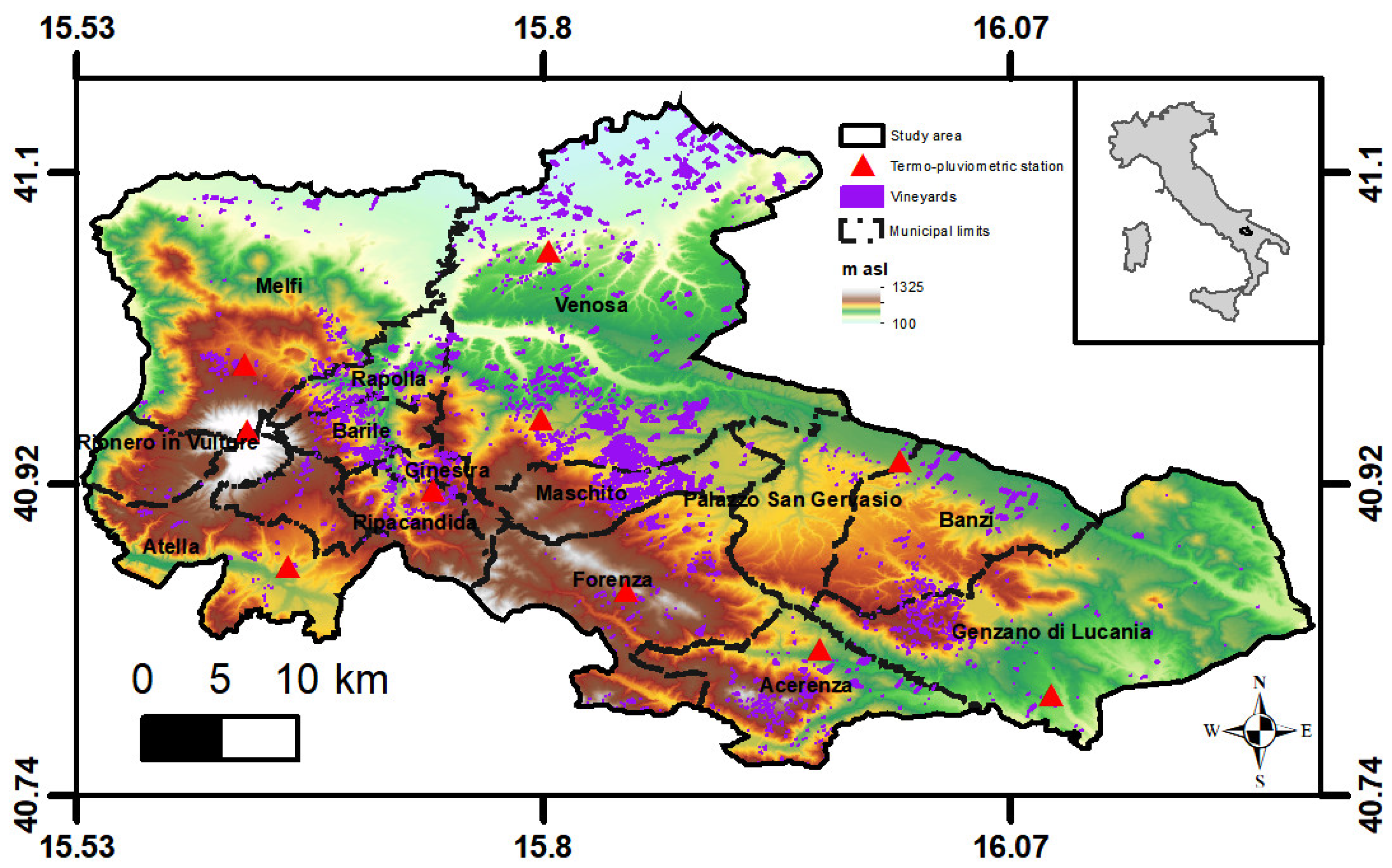
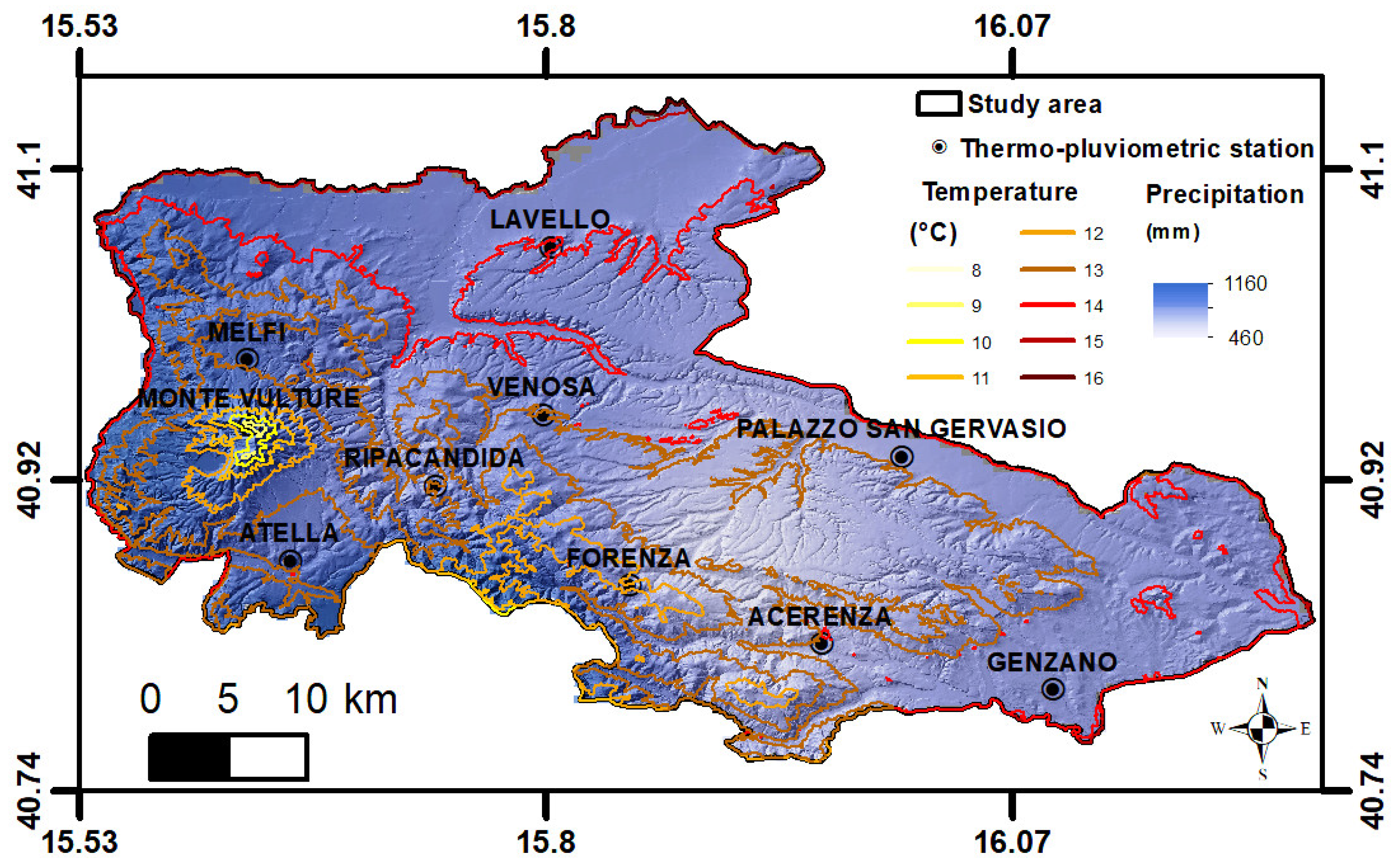
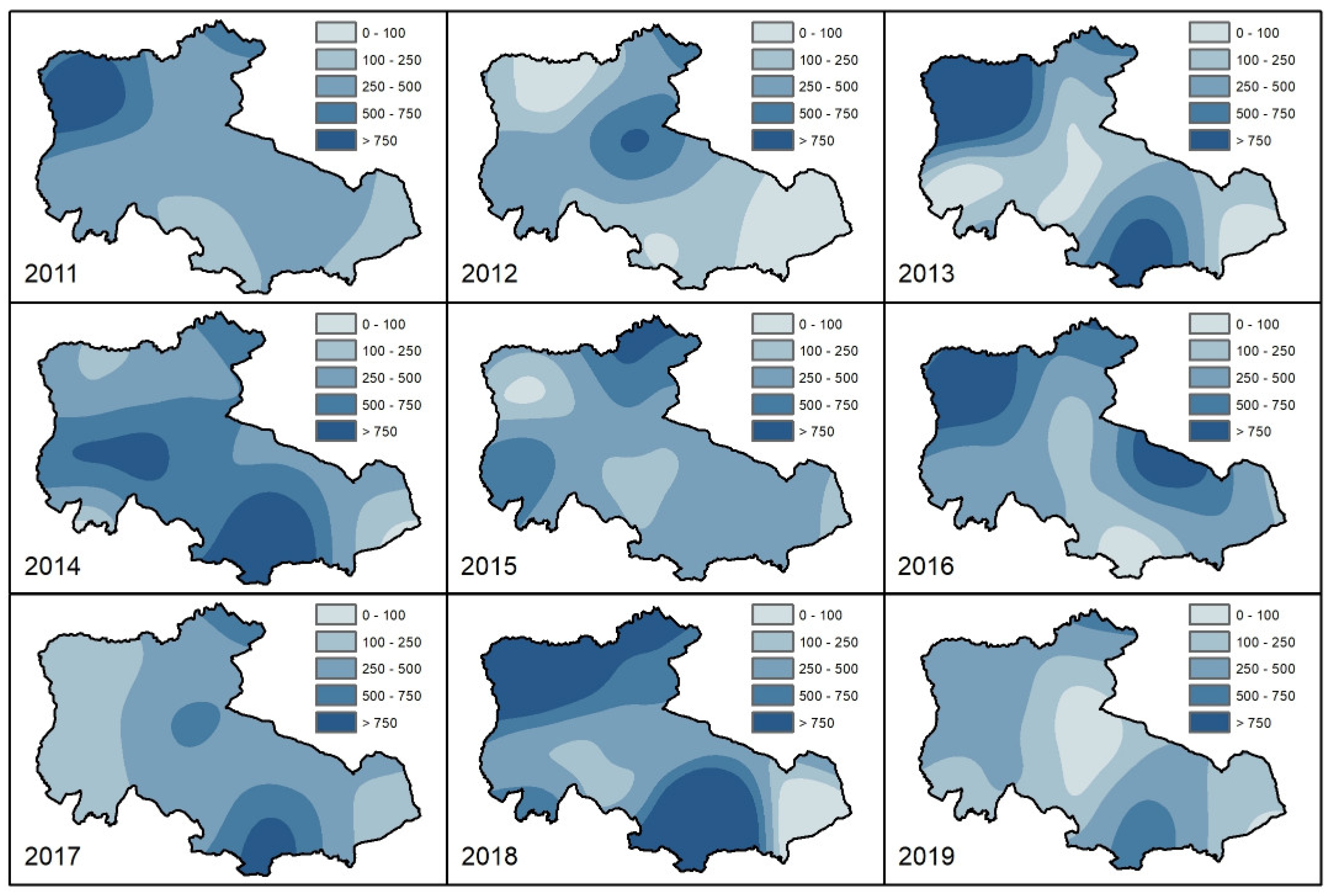

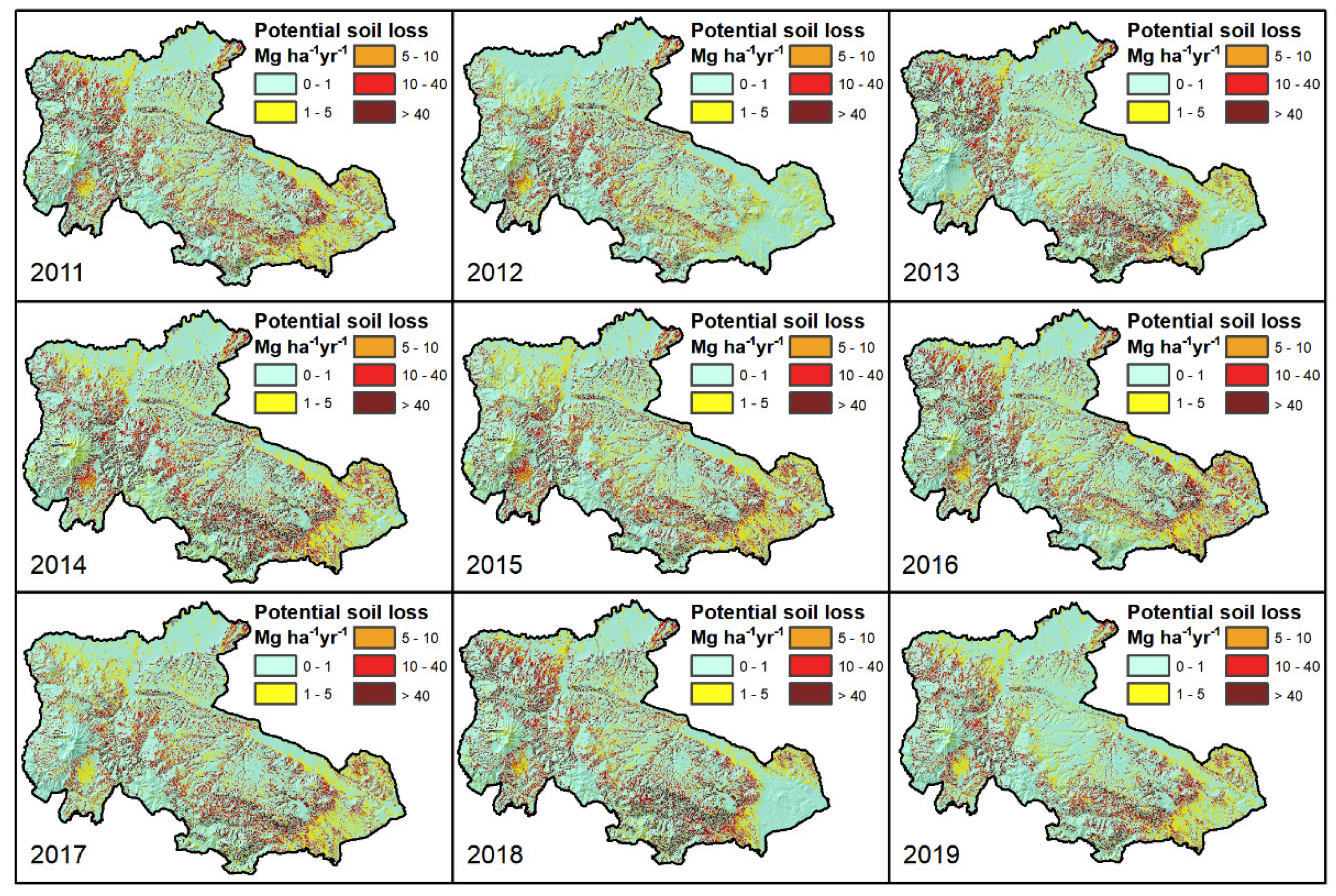
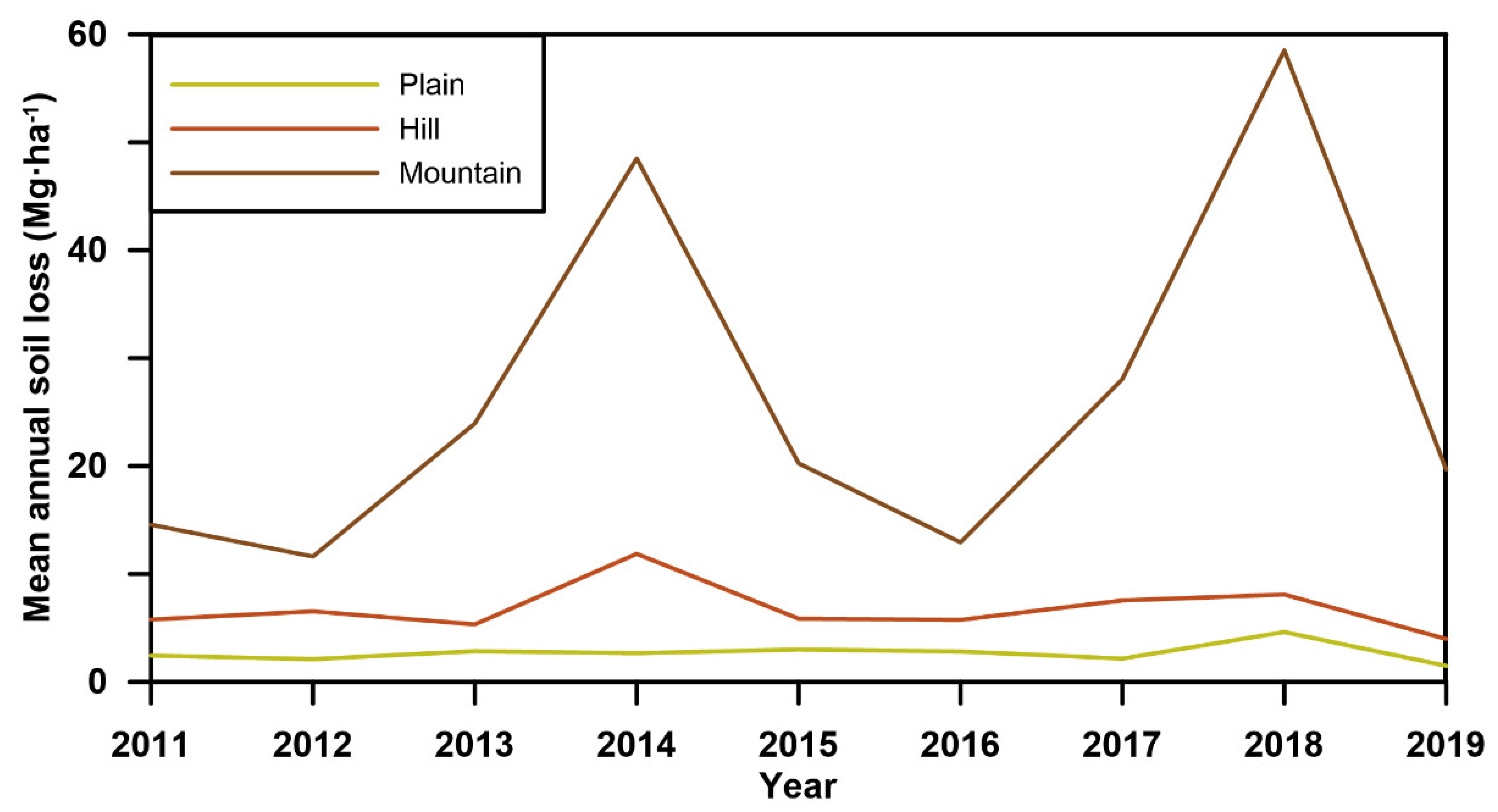
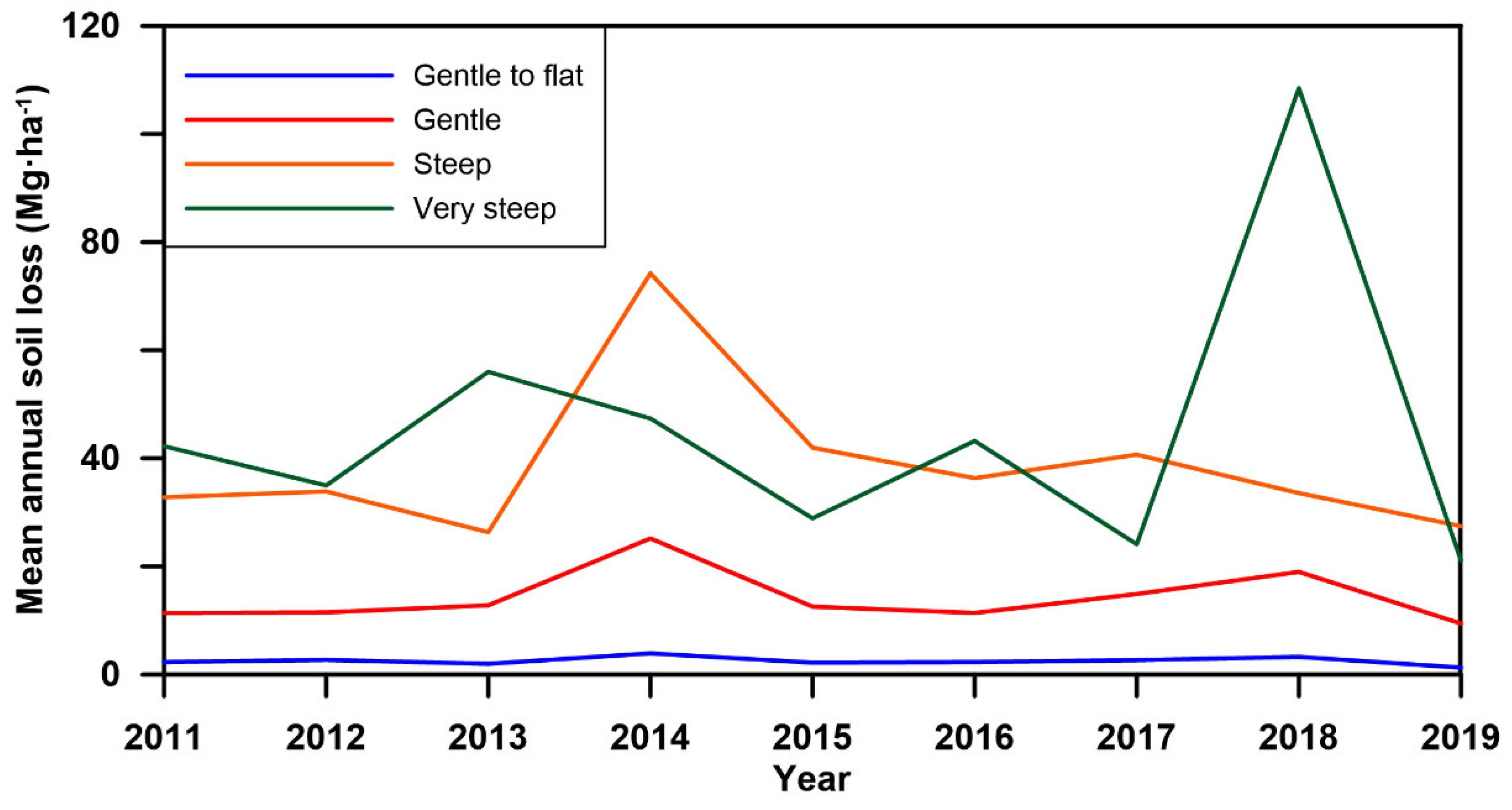
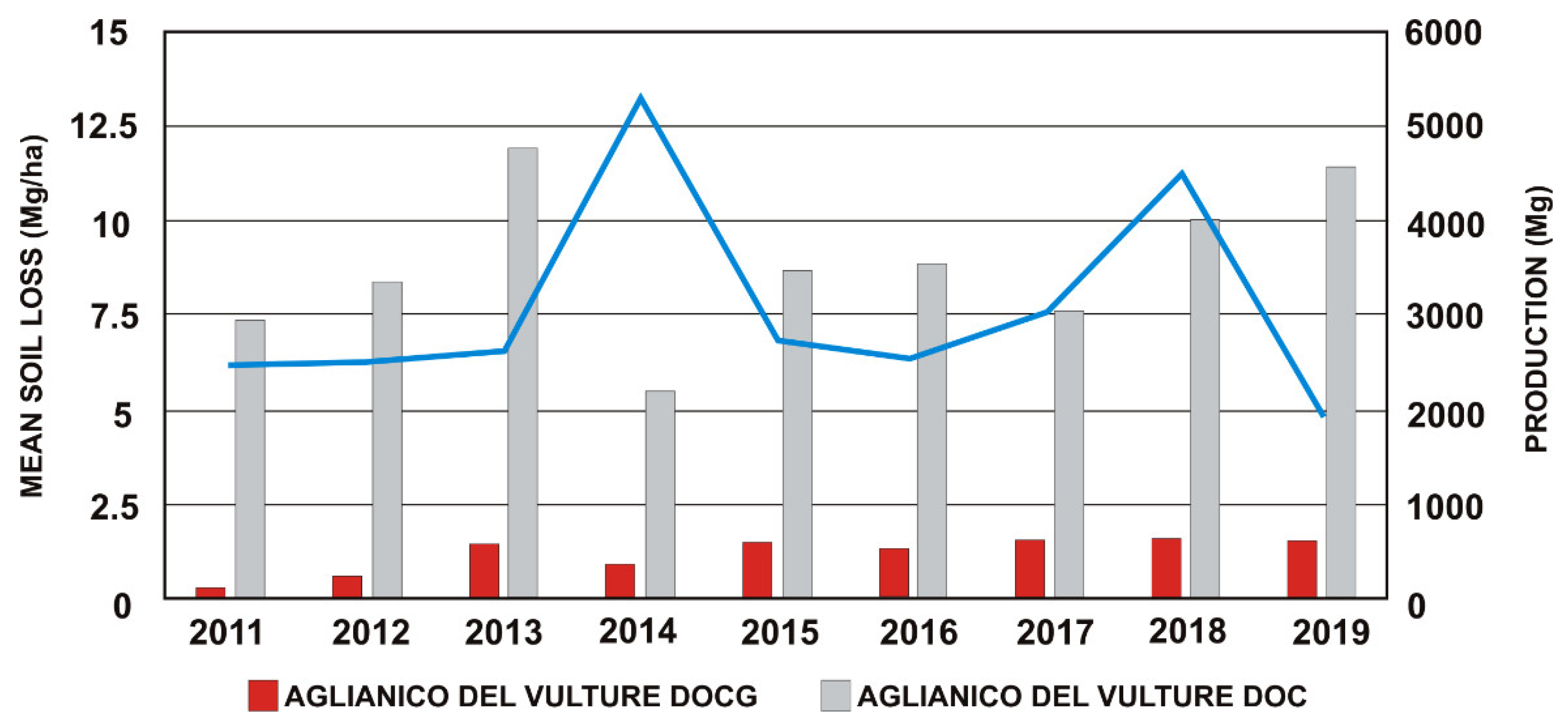
| Plain | Hill | Mountain | ||||
|---|---|---|---|---|---|---|
| Slope Classes (°) | km2 | % | km2 | % | km2 | % |
| gentle to flat (0–5) | 4.39 | 89.31 | 11.17 | 62.76 | 0.27 | 23.06 |
| gentle (5–15) | 0.52 | 10.58 | 6.23 | 35.00 | 0.80 | 68.32 |
| steep (15–30) | 0.005 | 0.10 | 0.39 | 2.19 | 0.10 | 8.54 |
| very steep (>30) | 0.0004 | 0.01 | 0.008 | 0.045 | 0.001 | 0.085 |
| Type of Coperture | Cfactor Value | Type of Cover | Cfactor Value | Type of Cover | Cfactor Value |
|---|---|---|---|---|---|
| Water bodies | 0 | Pastures | 0.004 | Crops | 0.2 |
| Urban areas | 0 | Shrubs | 0.003 | Vineyards | 0.27 |
| Scrublands | 0.1 | Forest | 0.001 | Fruit trees | 0.28 |
| Grassland | 0.009 | Vegetable gardens | 0.3 | Olive groves | 0.35 |
| Land mainly occupied by agriculture, with significant areas of natural vegetation | 0.17 | Citrus groves | 0.12 | ||
| 2011 | 2012 | 2013 | 2014 | 2015 | 2016 | 2017 | 2018 | 2019 | |
|---|---|---|---|---|---|---|---|---|---|
| Vineyards | 6.19 | 6.28 | 6.57 | 13.20 | 6.76 | 6.43 | 7.85 | 11.35 | 4.92 |
| Plain | 2.44 | 2.11 | 2.85 | 2.66 | 3.00 | 2.82 | 2.16 | 4.62 | 1.49 |
| Hill | 5.78 | 6.54 | 5.33 | 11.87 | 5.86 | 5.75 | 7.55 | 8.10 | 3.98 |
| Mountain | 14.57 | 11.62 | 23.95 | 48.51 | 20.25 | 12.93 | 28.06 | 58.52 | 19.68 |
| Gentle to flat slopes | 2.31 | 2.70 | 1.98 | 3.91 | 2.19 | 2.31 | 2.66 | 3.26 | 1.28 |
| Gentle slopes | 11.36 | 11.50 | 12.80 | 25.17 | 12.56 | 11.39 | 14.90 | 18.99 | 9.43 |
| Steep slopes | 32.80 | 33.87 | 26.33 | 74.23 | 41.97 | 36.34 | 40.67 | 33.57 | 27.45 |
| Very steep slopes | 42.24 | 34.98 | 56.00 | 47.37 | 28.90 | 43.21 | 24.10 | 108.49 | 21.07 |
Disclaimer/Publisher’s Note: The statements, opinions and data contained in all publications are solely those of the individual author(s) and contributor(s) and not of MDPI and/or the editor(s). MDPI and/or the editor(s) disclaim responsibility for any injury to people or property resulting from any ideas, methods, instructions or products referred to in the content. |
© 2023 by the authors. Licensee MDPI, Basel, Switzerland. This article is an open access article distributed under the terms and conditions of the Creative Commons Attribution (CC BY) license (https://creativecommons.org/licenses/by/4.0/).
Share and Cite
Lazzari, M.; Piccarreta, M. Soil Erosion vs. Vineyard Productivity: The Case of the Aglianico del Vulture DOC and DOCG Areas (Southern Italy). Sustainability 2023, 15, 15700. https://doi.org/10.3390/su152215700
Lazzari M, Piccarreta M. Soil Erosion vs. Vineyard Productivity: The Case of the Aglianico del Vulture DOC and DOCG Areas (Southern Italy). Sustainability. 2023; 15(22):15700. https://doi.org/10.3390/su152215700
Chicago/Turabian StyleLazzari, Maurizio, and Marco Piccarreta. 2023. "Soil Erosion vs. Vineyard Productivity: The Case of the Aglianico del Vulture DOC and DOCG Areas (Southern Italy)" Sustainability 15, no. 22: 15700. https://doi.org/10.3390/su152215700







